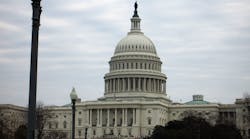Is Washington ready to tackle a larger infrastructure bill?
House Democrats and President Donald Trump have found themselves in rare agreement that the time to take up a large infrastructure package is now.
In a Tuesday tweet, President Trump called for a “very big & bold” infrastructure bill, citing low interest rates.
Congress and the president have enacted three stimulus bills aimed at helping the United States deal with the COVID-19 pandemic and the fourth stimulus package may include long discussed infrastructure considerations.
House Democrats held a press call on April 1 reiterating their priorities that were included in their Moving Forward Framework proposal, which was released earlier this year. The five-year, $760-billion proposal included $329 billion in highway investment, $105 billion in transit investment and $55 billion in rail investment.
House Speaker Nancy Pelosi (D-CA) said on the call that infrastructure investments needed to address vulnerabilities in America “laid bare by the coronavirus” and pointed to community health centers, broadband, clean water and mobility as examples of where investment is needed.
“For strong recovery, we must invest in smarter, safer infrastructure that is made to last. We can create millions of good-paying jobs building infrastructure and by strengthening commerce and reducing air pollution that harms the public health,” said Speaker Pelosi.
U.S. Rep. Peter DeFazio (D-OR), who is chairman of the House Transportation & Infrastructure Committee, told those on the call that he would push for sustainability to be included in any infrastructure package.
“I believe climate change is, even in times of coronavirus, an existential threat and if we’ve got to rebuild our infrastructure let’s rebuild it in a way that is resilient for severe climate events. Let’s rebuild it with new materials that are less carbon intensive. Let’s rebuild it in a way so we move away from fossil fuel dependence in transportation. If you’ve got to rebuild it, rebuild it the right way. And this is an investment we have to make,” said Rep. DeFazio.
While a final bill is still many steps away, agreeing on a concept is progress. That progress was lauded by the American Public Transportation Association (APTA), which noted both House Democrats and the president have made it clear that “increasing investment now in America’s infrastructure will be a critical step in fueling the nation’s economic recovery.”
“Increased investment in infrastructure creates jobs and strengthens local economies, and that is exactly what America needs right now,” APTA President and CEO Paul P. Skoutelas said. “As the nation moves forward and works to address the effects of the ongoing COVID-19 crisis, renewed investment in public transportation infrastructure will provide a solid economic foundation for recovery.”
APTA has proposed a six-year, $178-billion investment that supports its surface transportation priorities of maintaining and expanding the nation’s public transportation network while growing jobs, supporting communities and providing expanded mobility options.

Mischa Wanek-Libman | Group Editorial Director
Mischa Wanek-Libman is director of communications with Transdev North America. She has more than 20 years of experience working in the transportation industry covering construction projects, engineering challenges, transit and rail operations and best practices.
Wanek-Libman has held top editorial positions at freight rail and public transportation business-to-business publications including as editor-in-chief and editorial director of Mass Transit from 2018-2024. She has been recognized for editorial excellence through her individual work, as well as for collaborative content.
She is an active member of the American Public Transportation Association's Marketing and Communications Committee and served 14 years as a Board Observer on the National Railroad Construction and Maintenance Association (NRC) Board of Directors.
She is a graduate of Drake University in Des Moines, Iowa, where she earned a Bachelor of Arts degree in Journalism and Mass Communication.



